Planting of vineyards is carried out not only in the southern latitudes. The culture is successfully grown in the northern regions and middle lane. It is able to take root and bear fruit in different climatic conditions, but requires careful and constant care. If it is not grown correctly, diseases appear. To prevent them, it is necessary to regularly process grapes with folk remedies or chemical compounds.
Content
- 1 Why do you need to process and spray grapes in the spring
- 2 Processing time and optimal timing
- 3 Biological products
- 4 Chemicals
- 5 Folk remedies
- 6 Grape processing in early spring after opening
- 7 Processing of grapes in spring after the dissolution of the buds and the appearance of foliage
- 8 Grape processing in spring before and during flowering
- 9 Spring treatment after flowering
- 10 Powdery Mildew Spring Treatment
- 11 Popular bugs
- 12 Reviews
Why do you need to process and spray grapes in the spring
Care for grapes in the spring includes the use of effective means of chemical origin. They effectively repel insects, destroy fungal spores in the early stages of appearance. If you spray the culture on time, pathogens will be destroyed immediately. This will prevent further adversity and help save future crops.
To process grapes from pests and diseases necessary with knowledge. Before choosing a drug for spraying, you need to know what diseases and insects can appear in the garden. The vine is most often affected by:
- peronosporosis;
- different types of rot;
- cancer of bacterial origin;
- anthracnose;
- chlorosis;
- spotting.
Of the pests, the vine is attacked:
- phylloxer;
- weevil beetles;
- tick;
- leaflet.
Processing time and optimal timing
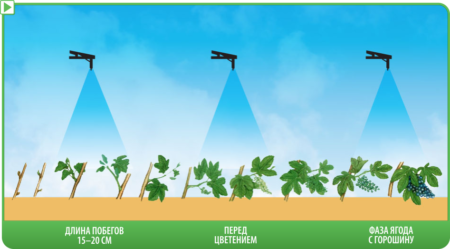
Sprinkling grapes in the spring is done on time. The first treatment should be carried out after removing the winter shelters. In early April, the culture is treated with antifungal agents. It is necessary to sprinkle not only the trunk itself and all the bends of the vine, but also the earth around. Spores of dangerous fungi are actively developing in it.
The next treatment is carried out closer to mid-April, when insects begin to wake up. The plant needs to be sprayed with insecticides so that the insects do not harm the blooming buds. If the culture is severely affected, after 10 days it is re-processed.
After the flowering stops, the last treatment is done, in the third decade of the month. To do this, the insecticide is mixed with a fungicide, checking their compatibility.
Biological products
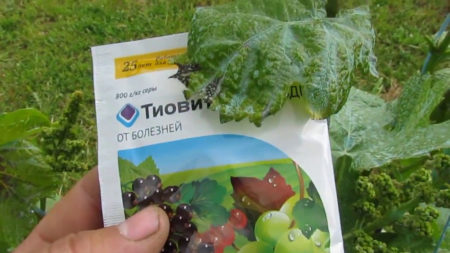
These drugs are more humane than chemicals. They include healthy mushrooms (saprophytes) and hay bacillus. When processing grapes in the spring from diseases these substances destroy almost all pathogenic fungi and microorganisms.
Fitosporin
Phytosporin destroys manifestations of late blight, rot of roots, rust and oidium (powdery mildew). Before use, 1 tablespoon of Fitosporin is diluted in 10 liters of water.
Trichodermin
The beneficial fungus in the composition of Trichodermin helps to convert plant and animal residues into inorganic. It is used for treatments from 60 different diseases. Among them - powdery mildew, peronosporosis and late blight. 50 ml of trichodermin should be diluted in 10 liters of water. The water is pre-settled and heated to room temperature. The vine should be processed only after the dissolution of the foliage. The interval between sprayings is from 10 to 20 days.
Actofit
The substance consists of toxins of natural origin. Actofit treatment is carried out if the plant is affected by a grape leafwort and a spider mite. 20 ml of the solution must be diluted in 10 liters of water.
Chemicals
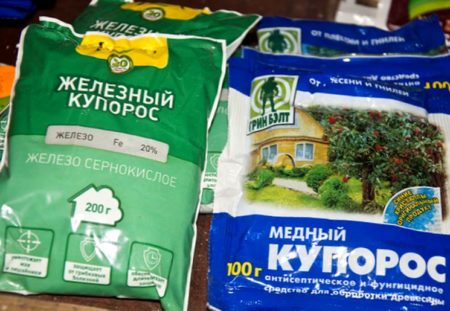
Than spray grapes in the spring, if other drugs are ineffective? Toxic, but effective chemical compounds will come to the rescue. When used correctly, they will not harm the plants and will quickly help to cope with diseases and pests.
Blue vitriol
The results of its application are impressive even for experienced gardeners. Sometimes expensive drugs are inferior to him in effectiveness. Copper sulfate destroys all types of pathogenic fungi, but for proper processing it must be properly prepared:
- pour quicklime into an iron bucket - 300 g;
- pour water - 2 l;
- mix
- move away from the tank, as it will begin to boil;
- put vitriol in another bucket - 300 g;
- pour hot water - 8 l;
- mix until a thick composition;
- add it to the lime;
- mix again;
- strain.
inkstone
Experienced gardeners know how to spray grapes in the spring before buds open. For this purpose, a solution of ferrous sulfate is used. It helps save grapes from mildew, anthracnose and any rot. With buds, the culture is sensitive to spring frost. Iron sulfate inhibits the dissolution of the kidneys, helping the plant retain strength and preventing the harmful effects of cold. It is necessary to dilute 0.5 kg of iron sulfate in 10 liters of water and process the grapes after the winter shelter has been removed.
Bordeaux mixture
“Bordeska” destroys all types of fungal infections of grapes, including all types of rot and anthracnose. The solution is used before the dissolution of the kidneys (2-3%). The Bordeaux mixture is also used to process grapes during the color period, reducing its concentration to 0.5-1%. The solution helps to slow down the growth of the culture; therefore, it is often undesirable to use it.
Urea
Urea, or urea, is half composed of nitrogen. Grape processing is carried out in the spring, using it as a top dressing. The substance fills the earth with useful substances, and also destroys fungi and harmful insects. Urea is active against scab, and if there are coppers and caterpillars on the grapes, there is no better way. Prepare the product by dissolving in 10 l of water 700 g of the substance.
Reedomil and quadrice
Ridomil and quadrice are non-toxic, but cope with many types of fungi: rot, spotting, rubella, peronosporosis. Due to their low toxicity, the preparations do not harm bumblebees and bees, and they can always pollinate the plant. Destruction of pathogenic fungi occurs a day after spraying.
Colloidal sulfur
Helps to cope with anthracnosis, spider mites and oidium. The effectiveness of the drug increases if it is mixed with copper-containing fungicides.
Folk remedies
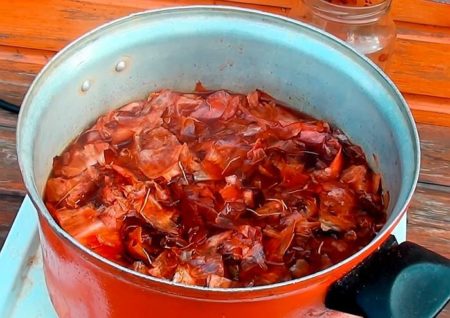
Horsetail and garlic are effective folk remedies.They help to cope with fungi and even mildew. You need a strong decoction, in the ratio of 75 g of garlic or horsetail to 10 liters of water. Ticks can also be destroyed by decoction from the tops of potatoes: it is necessary to pour 2 kg of tops of 10 liters of water.
A good prophylactic is onion peel. It prevents the appearance of fungal spores. It is used both before and after the flowering of the vine. To prepare the infusion, take a 10-liter bucket and fill it with husk half. It remains to boil the mixture over low heat for 20 minutes. After boiling, it must be infused for a day, then add a tablespoon of honey, bring the amount of water to 10 l and strain.
Grape processing in early spring after opening
After the shelter is removed from the grapes for the winter, it is cut off and the bush is cleaned of debris. The entire territory on which the vine grows must be treated with a 3% solution of “Bordeaux” or Ridomil. All available will do. fungicides: BOTTOM, copper or iron sulfate. Of folk remedies, onion husks are often used (the method for preparing a decoction is described above).
Processing of grapes in spring after the dissolution of the buds and the appearance of foliage
After the dissolution of the buds and the appearance of green leaves, the vine shoots are sprayed with "Ridomil" or a soda-containing solution. Soda solutions that quickly destroy caterpillars are popular among the people. Here is a simple recipe for one of them:
- take a little soda and flour in equal proportions;
- stir;
- dilute in water;
- immediately spray the grapes.
You can use a dry mixture, without adding water.
There is another popular chemical product - Chorus. It is used both for therapeutic and prophylactic purposes. It is simple to prepare: you need to stir 2 g of the product in a large bucket of water. As always, spraying should be carried out in cloudy weather.
Grape processing in spring before and during flowering
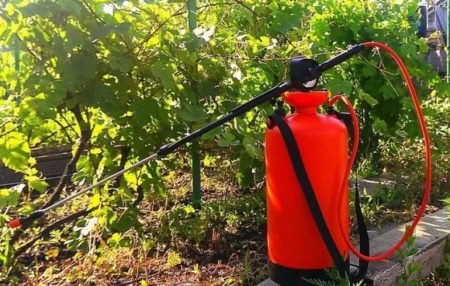
How to handle grapes during flowering and earlier? Gardeners spray the vine with “Agate 25-K” (based on 1 g of substance in 5 l of water). Process the vine immediately after diluting the solution. If during this period the grapes are not affected by insects, processing is not necessary.
Spring treatment after flowering
After flowering, the vine is sprayed with chemicals and folk remedies. For example, 50 g of baking soda is dissolved in 10 l of water. You can add a little liquid soap - 15 g. Of the chemicals, “Tiovit Jet” is suitable. To prepare it, 50 g of the substance are diluted in water (3 l), thoroughly stirred and the volume of water is adjusted to 10 l. The tool helps to get rid of oidium and all types of ticks.
Powdery Mildew Spring Treatment
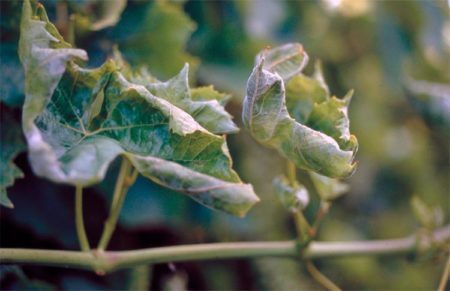
This disease is called oidium. It is manifested by rotting fruits and a deterioration in the appearance of shrubs. You can deal with powdery mildew in one of several ways:
- infusion of ash - at the rate of half a bucket of ash per 7 liters of water. The solution is insisted 24 hours or boiled for 20 minutes. After boiling, a little soap is added to the ash and the mixture is diluted with warm water in a ratio of 1: 1;
- milk solution - 1 liter of milk is diluted with 10 liters of water. The solution is used immediately;
- soap-soda composition - based on 20 g of soap and 20 g of soda on a large bucket of water.
Popular bugs
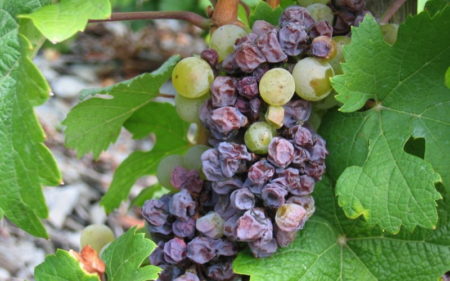
Proper processing of the vine implies strict adherence to the timing and time of manipulation - otherwise, it will not give any effect. It is necessary to carefully prepare solutions. If concentration is not respected, this can destroy the grapes. You can also not start the disease, if it is already there, and hope that the vine will cope with it on its own. In case of damage by insects or fungi of a large area of the vine, the treatment process is delayed, and the harvest will not have to be expected at all.
Reviews
Valentina (Krasnodar):
“After the leaves appeared on the vine, caterpillars started. I did not want to “poison” the grapes with chemicals, because there were few caterpillars. I took advantage of a folk remedy. She took a handful of flour and a handful of soda, mixed, poured water, sprayed a bush from a spray bottle. After the first use, the tracks became smaller, and after the second they completely disappeared. I believe that if there are few pests, you can not be too lazy and use those components that can always be found in the kitchen. ”
Svetlana (Gelendzhik):
“I bought a cottage in a lowland, the site turned out to be neglected. Several groomed vineyards were affected by fungus in many places. The neighbor advised to process with copper sulfate. I diluted the solution, as expected, carefully sprayed all the bushes. After some time, the bush began to recover and come to life before our eyes. Vitriol acts perfectly, but you need to carefully observe the proportions when breeding it, and it takes a lot of time. But the process is worth it! ”
Grapes - a sensitive culture, although it grows in many places. To get a good harvest, you must observe the processing time of the vine and regularly inspect it for the appearance of fungi and harmful insects.





 Non-covering winter-hardy grape varieties for Moscow region
Non-covering winter-hardy grape varieties for Moscow region How to keep the vine in winter
How to keep the vine in winter When can I transfer grapes to another place in the fall
When can I transfer grapes to another place in the fall How to cover and prepare grapes for the winter in the suburbs
How to cover and prepare grapes for the winter in the suburbs